|
USS Theodore
Roosevelt (TR) CVN-71 2008 Press Trip
I had the rare and very exhilarating
opportunity to spend 24 hours on the USS Theodore Roosevelt on July 26-27,
2008 as a media VIP. We came aboard in a Grumman C-2A around 2 PM on
Saturday, July 26th and then left on the same type aircraft at 2:30 PM on
Sunday, July 27th, 2008. In the intervening 24 hours we were on the
flight deck twice on Saturday, and once on Sunday morning for sunrise.
We also visited Air Ops, the hangar deck, the Admiral's deck with a 15
minute interview, and many other locations during our short visit.
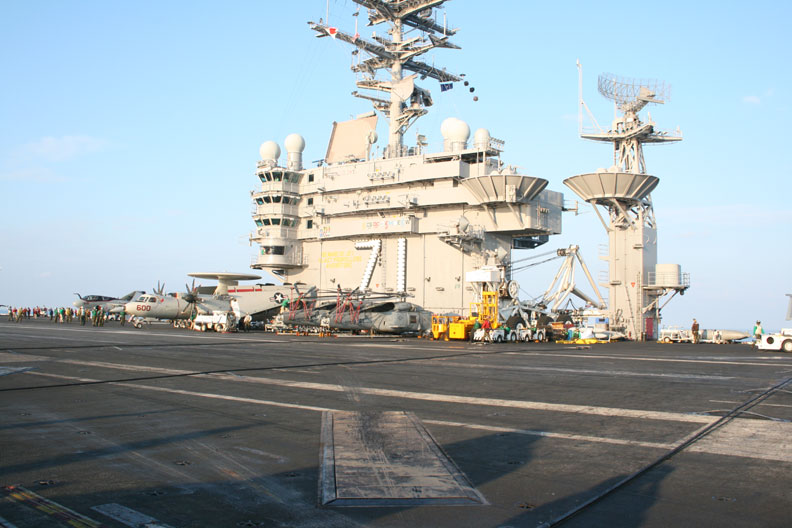
The aircraft that serve aboard the TR belong
to Carrier Wing 8, which includes both the F-18 Hornet and Super Hornet,
the EA-6B Prowler, the E-2C Hawkeye, and the Sh-60 Seahawk. The
E-2Cs belong to VAW-124, the SH-60s to HS-3,and the EZ-6Bs to VAQ-141.
Representatives of each are shown above as we await the next aircraft to
land. Note the arresting cables across the deck.
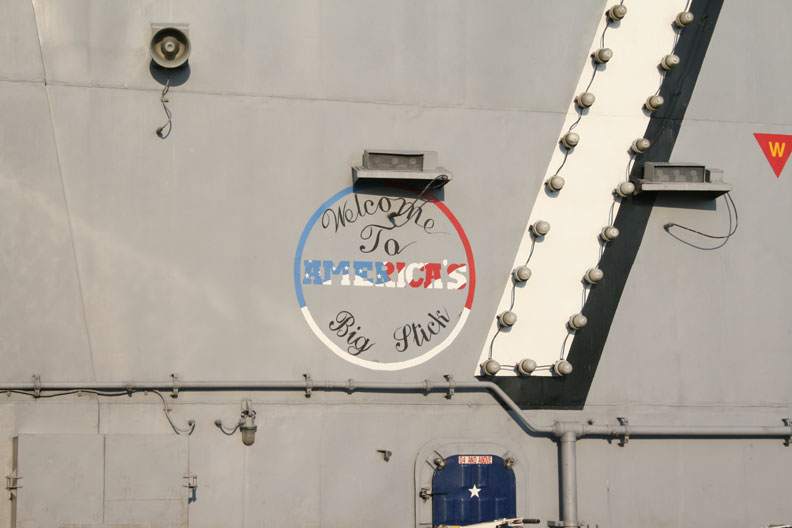
The USS Theodore Roosevelt is the fourth
Nimitz Class nuclear powered aircraft carrier built and operated by the
United States. The keel was laid on October 31 of 1981 and was
christened on October 25, 1986, having been built in the Hampton Roads
area at the Newport News Shipbuilding Company. As the TR is based at
Naval Station Norfolk across the river from Newport, CVN-71 is hometown
built and stationed carrier, which can be seen by many who built her when
she arrives and departs from port. Twice she has returned to the
Norfolk Naval Shipyard, which is actually in Portsmouth, VA,
about a mile upstream from her home port in Norfolk, for what the Navy
calls Planned Incremental Availability.
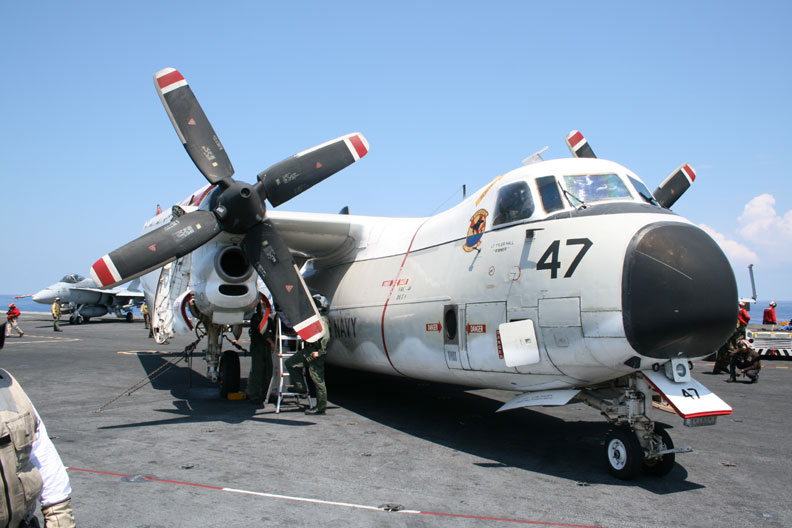
This is the C-2A that brought 15 of us
out to the carrier. The US Navy has 35 Greyhounds that it operates
from land bases to bring personnel and supplies out to the carrier and
then return personal back to the land base, which in this case is Chamber
Field (formerly NAS Norfolk) at Naval Station Norfolk. The C-2A
cruises at about 180 knots and when we went out to the TR we climbed to an
altitude of 13,500 feet. This particular aircraft is operated by
VRC-40, Det. 4 and has a crew of four, two pilots and two enlisted
personnel as loadmasters. The Greyhounds will be undergoing
upgrades staring later this year to include new glass instrument panels
and the 8 bladed curved props. At some point in time in the future
the C-2A will either be replaced with a new C-2B or the VS-22 Osprey.
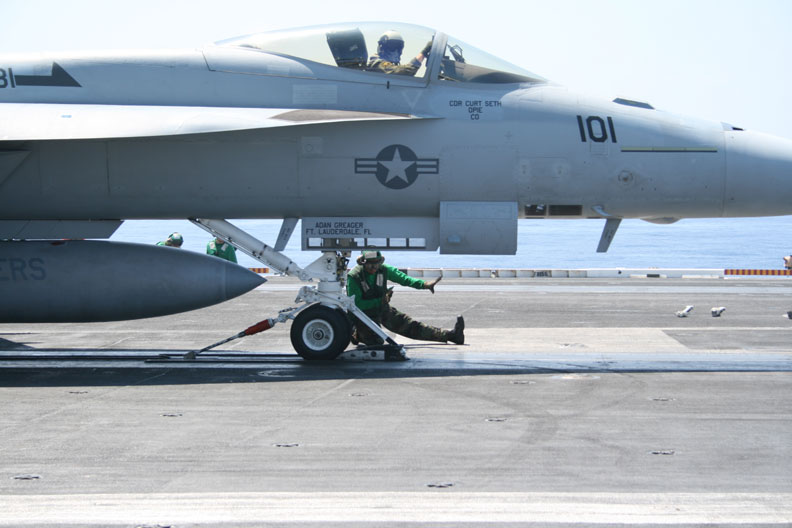
F-18 making its final shuttle attachments
before the launch. The young men and women of the deck crew put in
long, hot, grueling days on the flight deck of any US carrier. There
is only one shift and the crew starts early in the morning and the
Saturday I was there flight operations ran until well after midnight.
Launch and recovery cycles run every hour and a half, being initiated the
launch of the strike mission of around 16 aircraft. As soon the the
strike force has left the mission that departed an hour and a half earlier
is recovered. The aircraft then need to be moved to the proper
location on the deck, serviced and made ready for the upcoming launch
cycles. It is a never ending and continuous process.
The launch. I just put the camera in
auto advance mode, aimed down the deck, and then held the shutter button
down when I heard the launch. Several of the first photos in the
sequence were only shots of the deck as I was waiting for the F-18 to
enter the viewfinder. Two minutes later another aircraft was on its
way again.
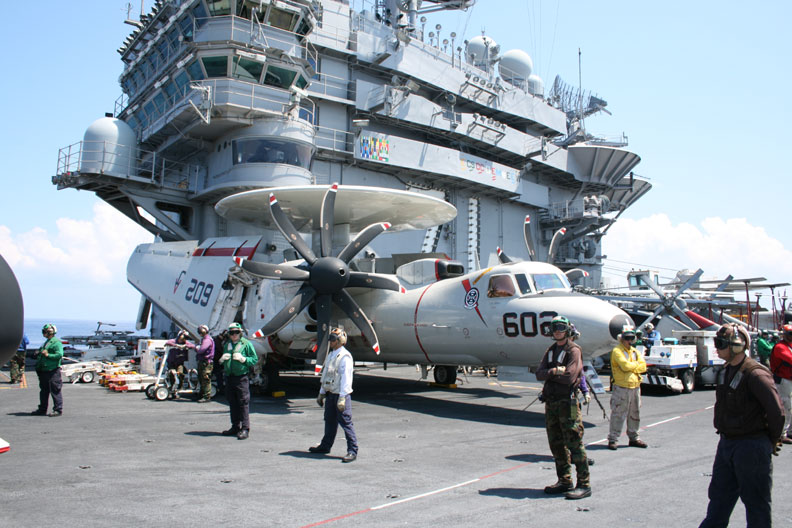
There are four E-2C Hawkeyes attached to each
carrier wing, with VAW-124 being the squadron attached to Carrier Wing
Eight that is on the TR. The Hawkeyes are the second aircraft
launched in the sequence, following the SH-60 plane guard which is always
first with its rescue swimmer. The E-2C will then climb to altitude
during the launch of the remaining aircraft to provide radar and radio
coverage for the strike force during its mission.
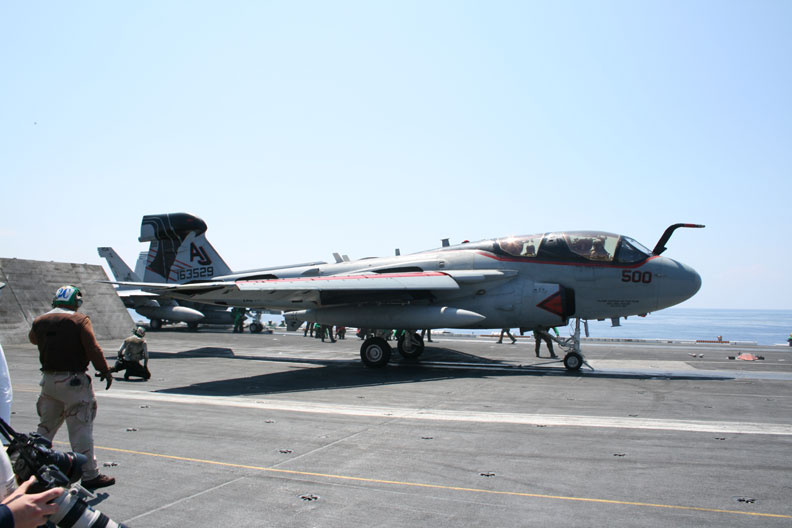
Grumman EA-6B Prowler ready to go. There
are 4 Prowlers on each carrier providing electronic countermeasure support
for the strike force. Note that the blast wall is up to deflect the
jet exhaust. I noted when at the aft of the ship that the blast from
the bow cats will still make its way to the rear and not only push you
around but warm you up.
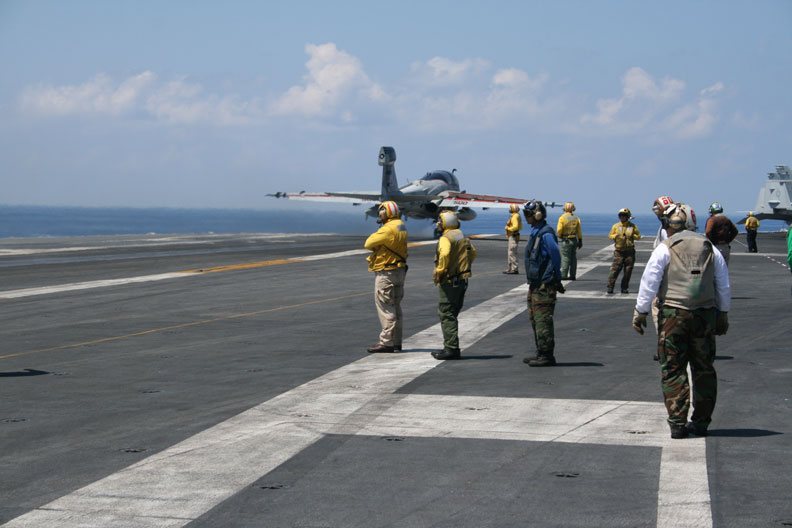
On it's way!!! White shirts are Safety
Observers and Landing Signal Officers. Those in yellow are catapult
and arresting gear officers, and traffic directors. Blue are tractor
drivers and elevator operators.
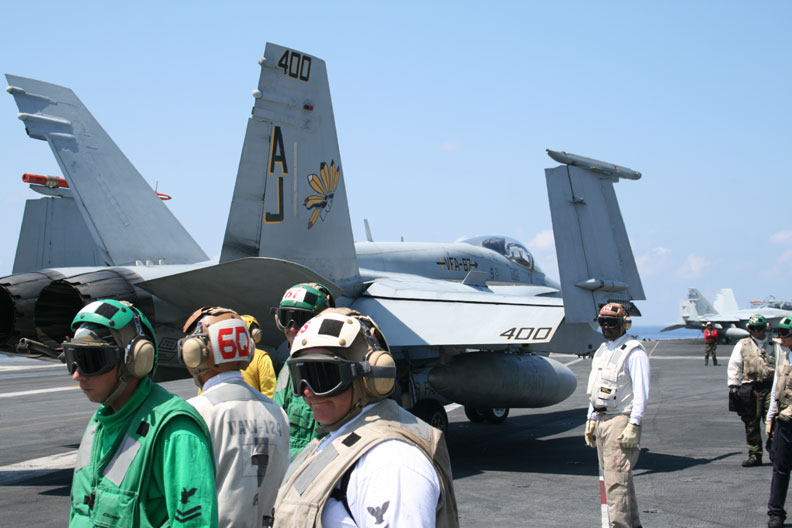
Things get real close on the carrier deck.
This F-18 Hornet from VFA-87 just taxied by us en-route to the bow
catapults from the aft of the ship. Something like this would never
happen at a land base. Anyone on the flight deck is required to wear
long sleeves, "cranials", which are the protective head gear with built in
ear and eye protection. The flight deck is an extremely noisy
environment and also with all of the jet engines and props blowing hot air
and possible debris, both the ears and the eyes need to be protected at
all times. Also required to be worn is the "float coat", which is
the vest everyone is wearing. Upon contact with water it
automatically inflates and sends out a GPS signal so that one can be
rescued quickly. The last time a sailor was blown overboard by jet
blast he was back on deck in seven minutes, having been rescued by the
SH-60 plane guard.
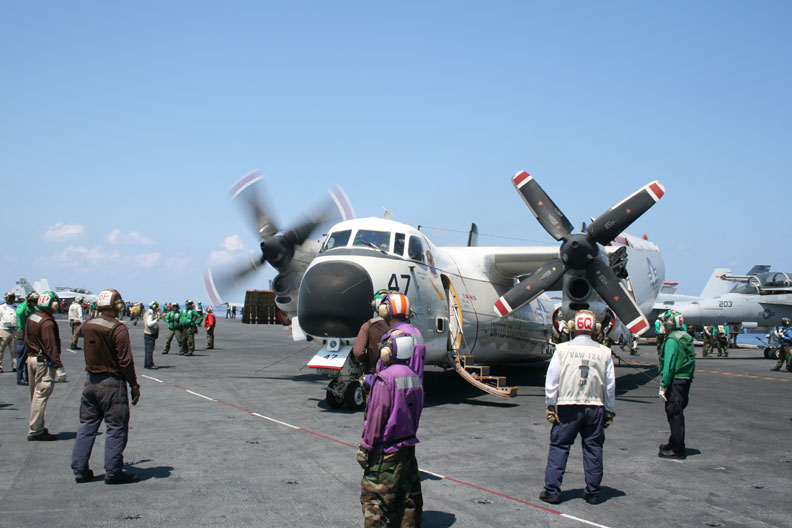
"My ride" preparing to return to Chambers
Field at Norfolk Naval Station. Purple shirts refuel the aircraft
while those in green are aircraft maintenance and arresting gear crews.
Brown are plane captains, who are the chiefs responsible for the
maintenance of the assigned aircraft.
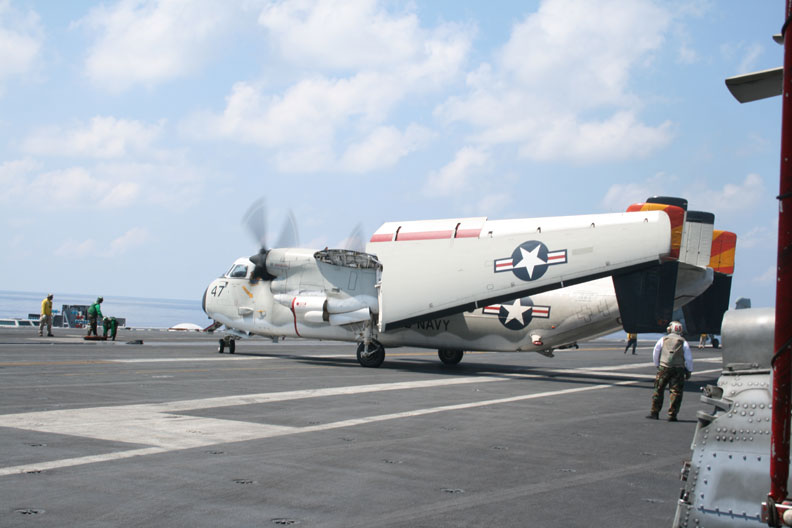
This is the C-2A all buttoned up and both
engines running as it gets ready to turn to the right to proceed to the
bow catapults. This Grumman designed and built aircraft, like the
S2F Tracker and OV-1 Mohawk, may not end up being a prom queen, but is
highly functional in being able to bring supplies and personal out to the
carrier and back to the home base. On this particular trip, the
Greyhound was taking a sailor who had broken his leg back to Norfolk for
more medical attention.
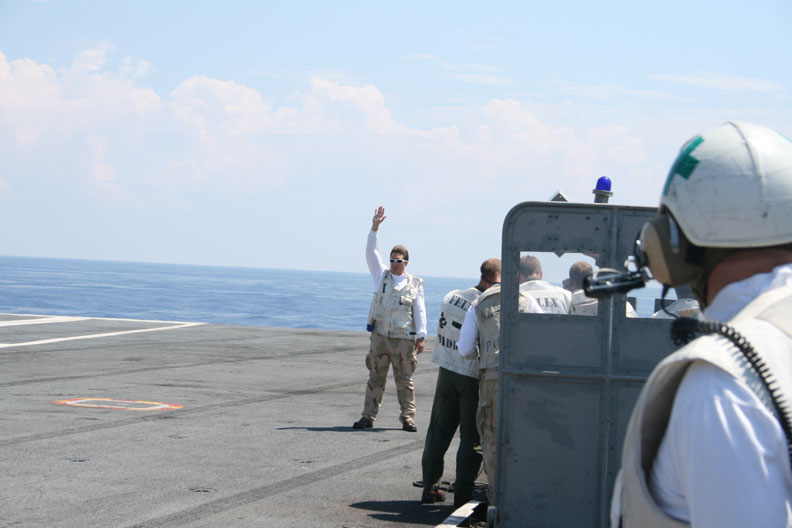
A Landing Signal Officer (LSO) signaling that
the deck is "fouled". In other words, the aircraft that has just
landed is still not clear of the landing area and is fouling the deck.
When the deck is clear he will put his arm down and the next aircraft will
be able to land. We had one F-18 that had to do a go around due to
fouled deck while I was in this location.
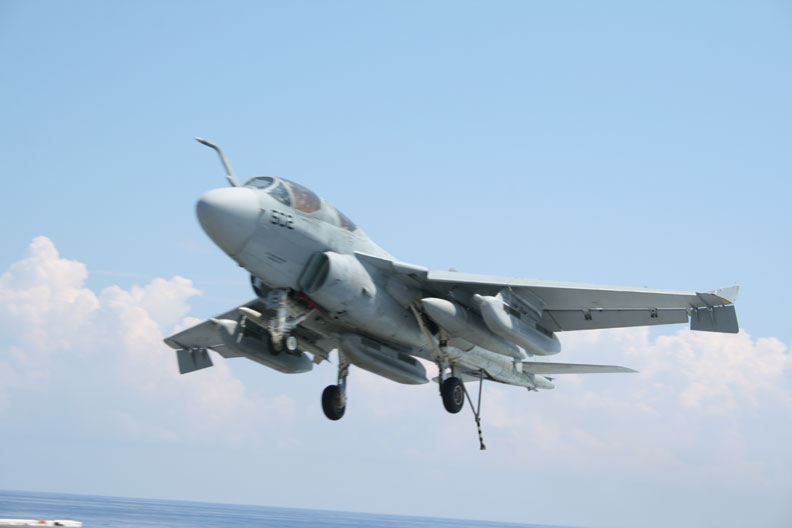
Grumman EA-6B Prowler just coming over the aft
of the carrier. The last of a long line of great Grumman A-6 Intruders and
EA-6 Prowlers.
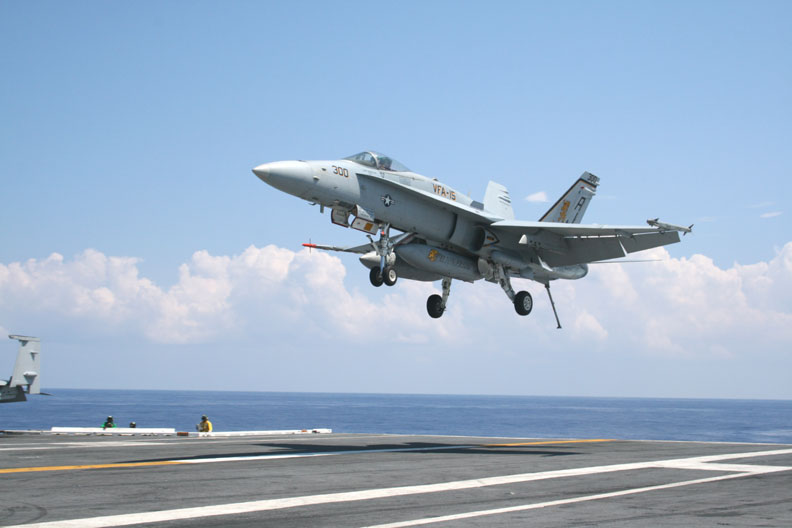
F-18 Hornet coming home! VFA-15 is one of
two Hornet Squadrons on the USS Theodore Roosevelt, along with VFA-87.
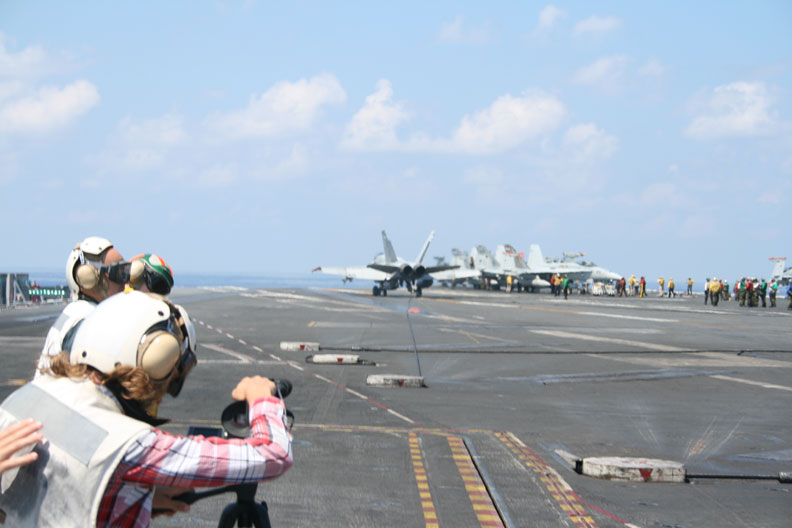
Catching the Number Three Wire. There
are normally four cables stretched across the deck to engage the tail hook
on the landing aircraft, with the number 3 being the most desirable to
trap. On this cruise the Number One wire had been removed as it
historically only traps 10 % of the landing aircraft.
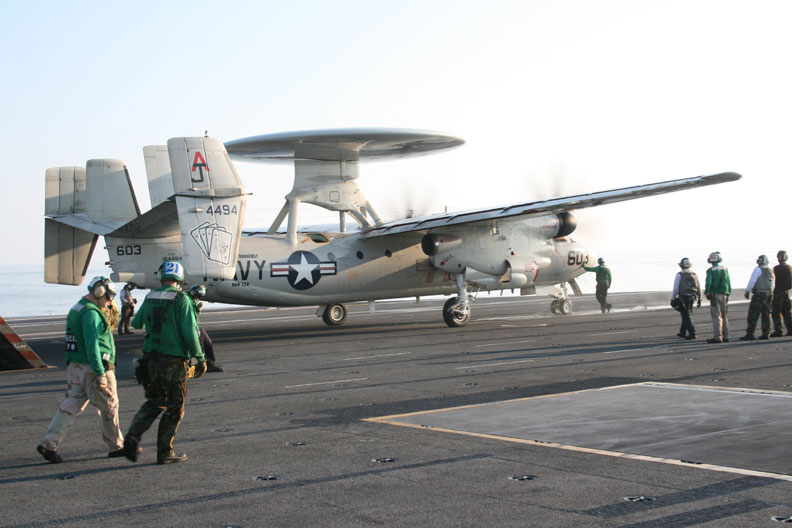
Hawkeye 603 being prepared for a cat shot off
the bow for the next flight rotation. About six feet in front of the
nose gear the shuttle can be observed as it is coming back for hookup to
the nose gear. The blast wall has been raised, so once the shuttle
is connected, and the final inspections have been made the E-2C will be
launched. Safety is paramount on the flight deck of a carrier, and
there are multiple safety inspections of the aircraft and launch system by
multiple persons, to make sure that each cat shot will go as planned.
Also, the Air Boss, watching from his perch on the island, can abort any
launch by pressing button on his control console.
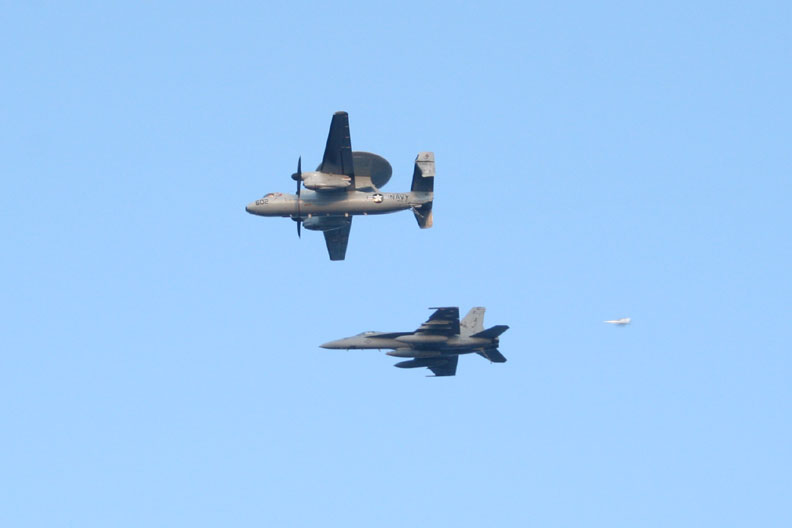
A rare formation shot of an F-18 and E-2C over
flying the TR in preparation for the break into the landing pattern.
Note that a second F-18 is also caught in the photo, flying a distance
away from the carrier.
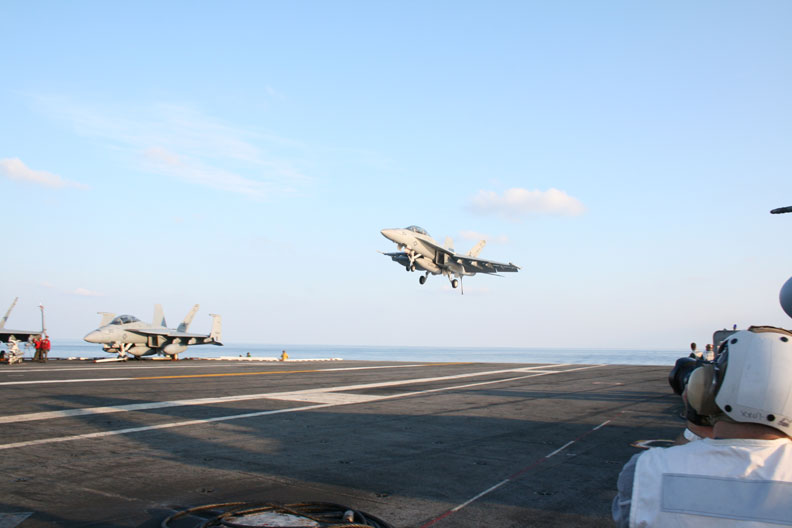
A F-18 Super Hornet getting ready to snag a
wire.
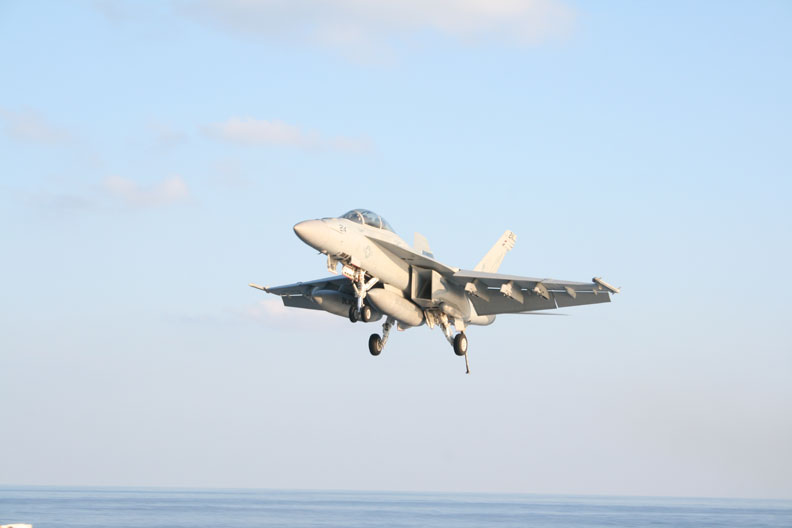
Two of the ways to distinguish a Super Hornet
from a Hornet is the the former has rectangular air intakes and three
pylons on each wing for stores. The Hornet has a curved intake and
only two hard points on each wing. This is due to the fact the
Super Hornet is 25% bigger and has a larger wing.
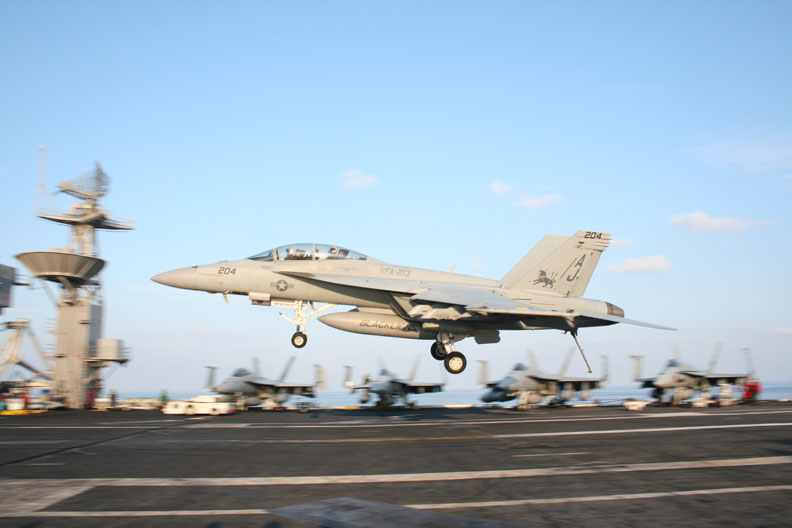
The Super Hornets are represented by VFA-213
and VFA-31 on the TR.
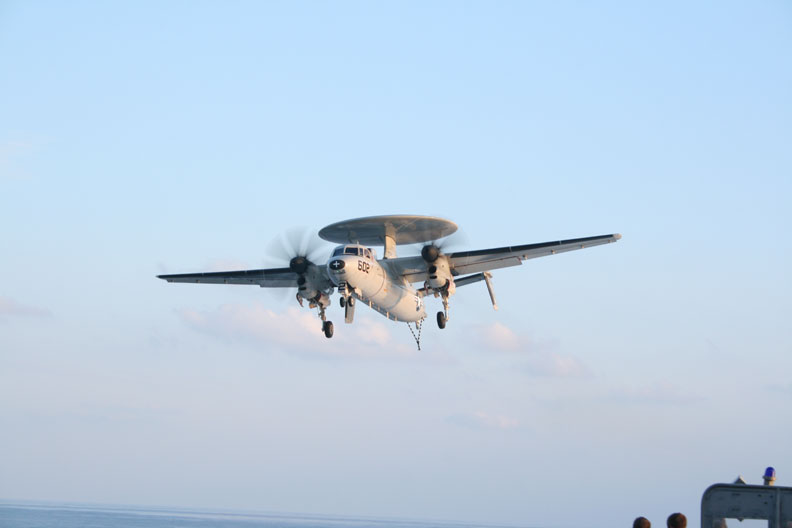
The Hawkeye coming home.
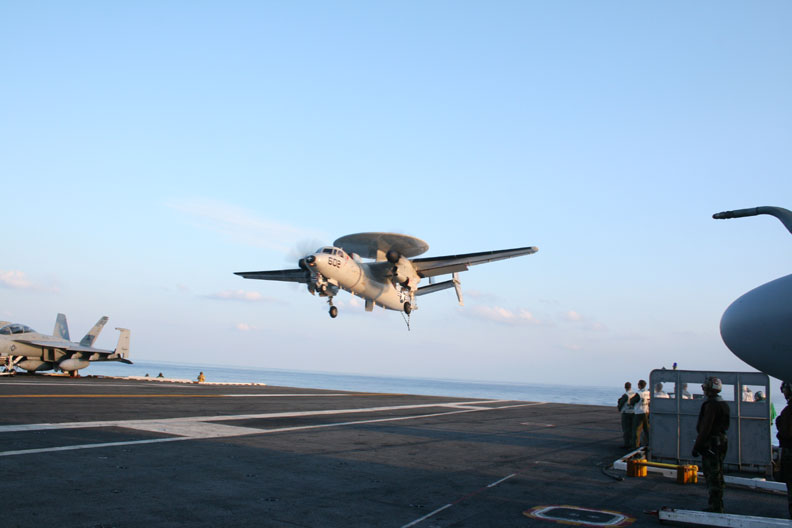
Almost there. Due to the wingspan, the
E-2C only has three feet of clearance off each wing tip when landing to
avoid striking aircraft that are spotted on the deck. This combined
with the fact that the both props turn in the same direction to reduce
complexity on the aircraft and in the supply chain, and the fact the
Hawkeye does not have an automatic landing system like the F-18s, means
that the pilot has to maintain constant vigilance right to the end.
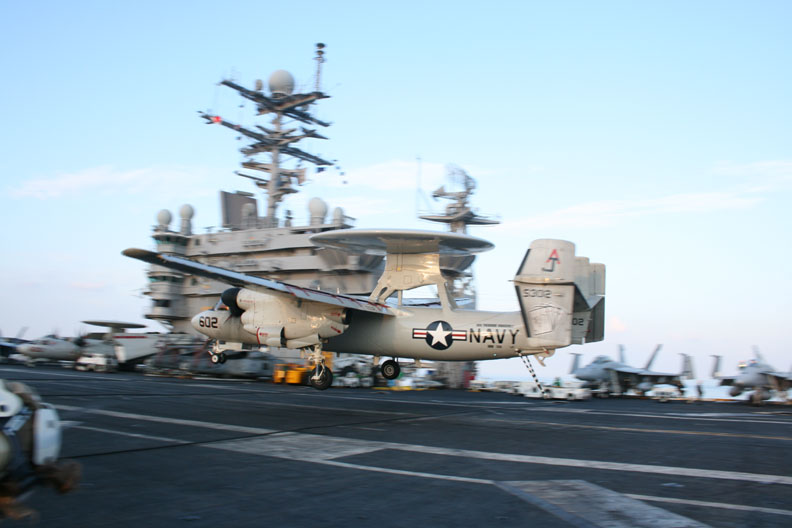
Ready to hook the wire. Note the
position of the wing in relation to the white safety line below. The
Hawkeye as stated above does not have a whole lot of "wiggle" room when
landing on the carrier. The pilot needs to hit the center line
every time.
This finished up our second
tour of the flight deck on Saturday.
|